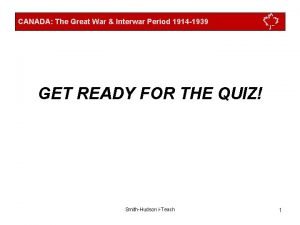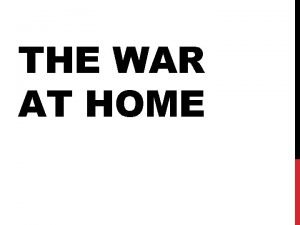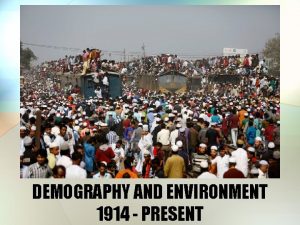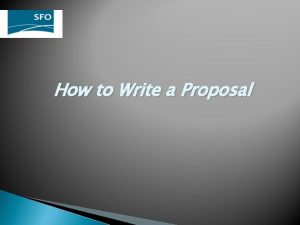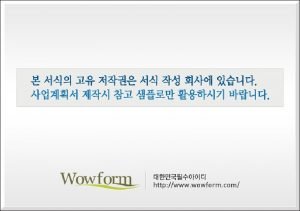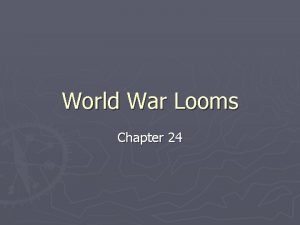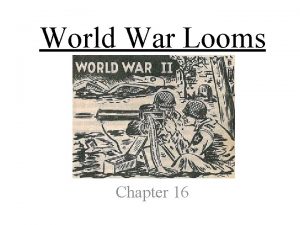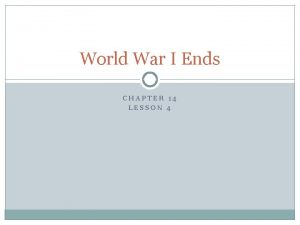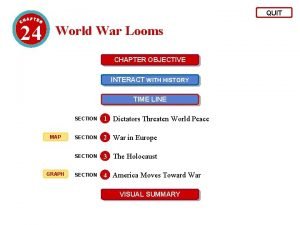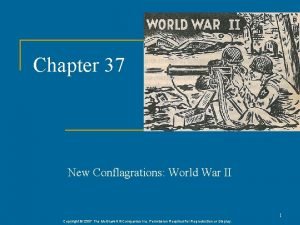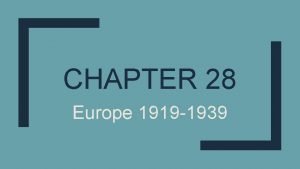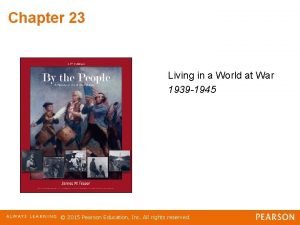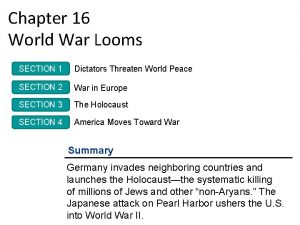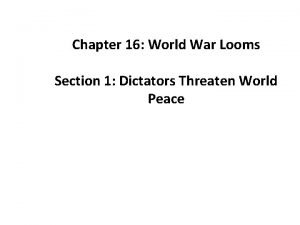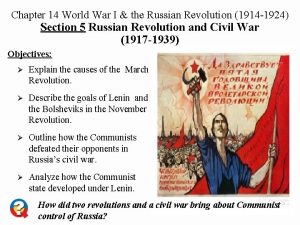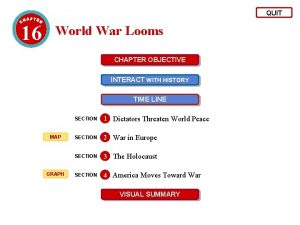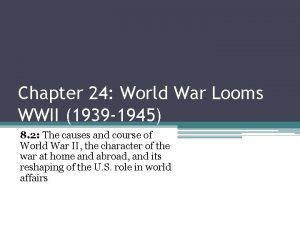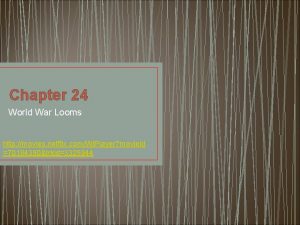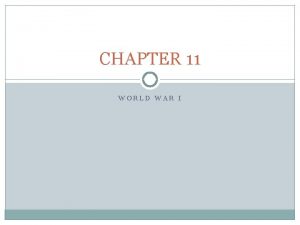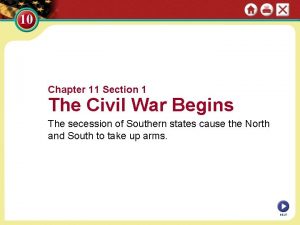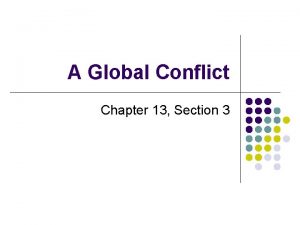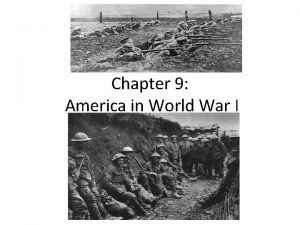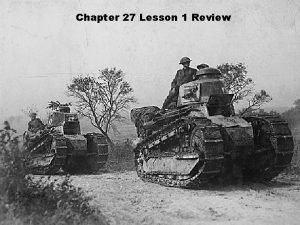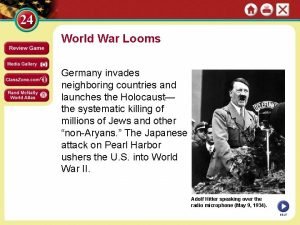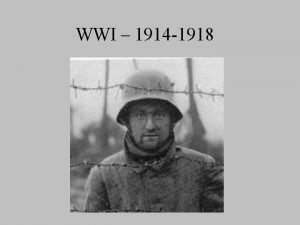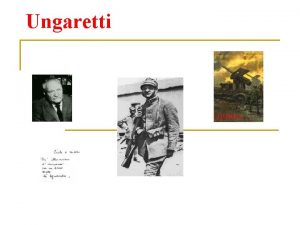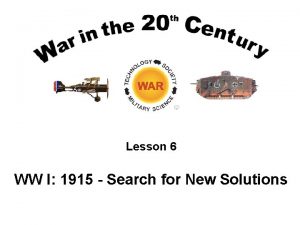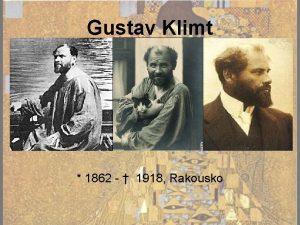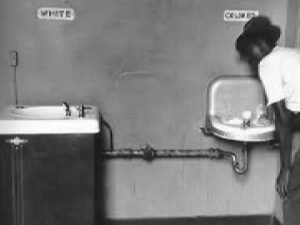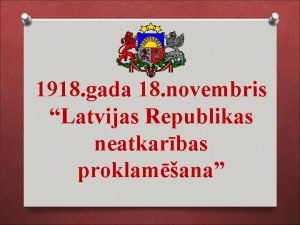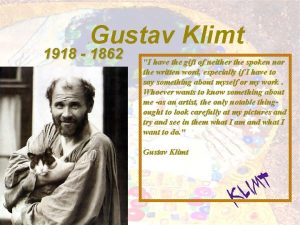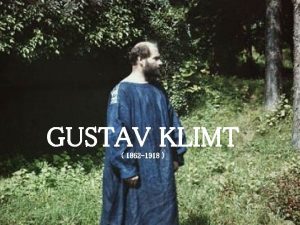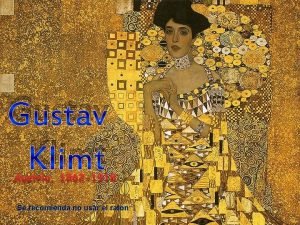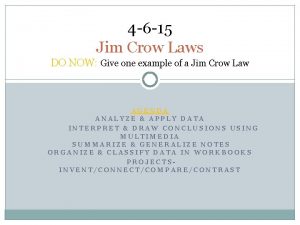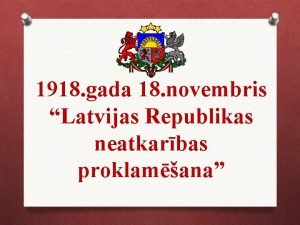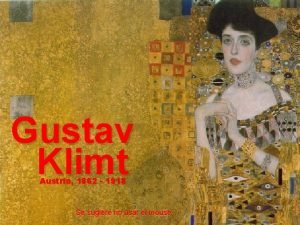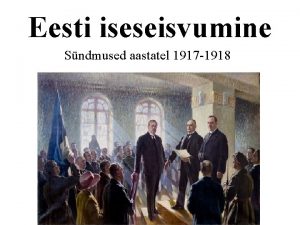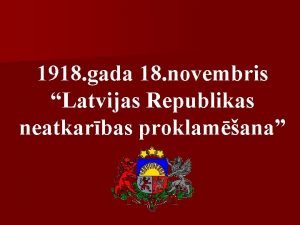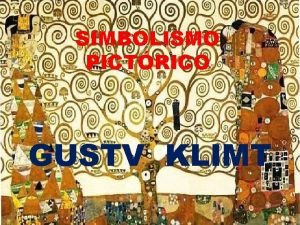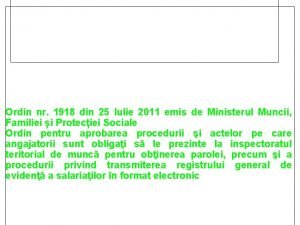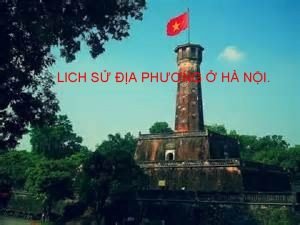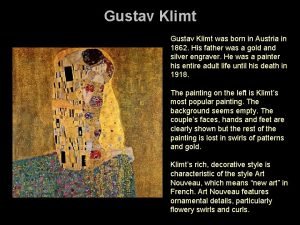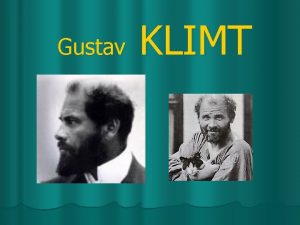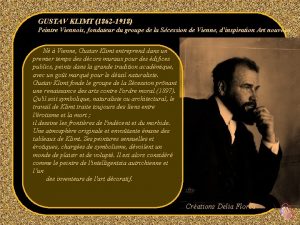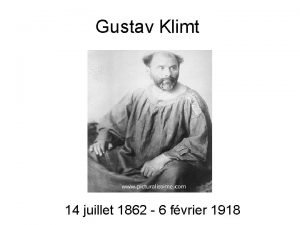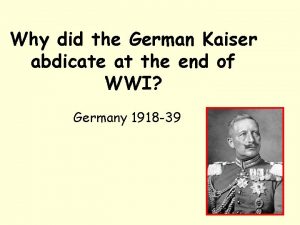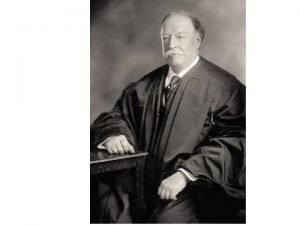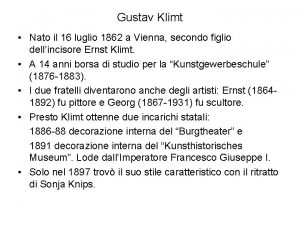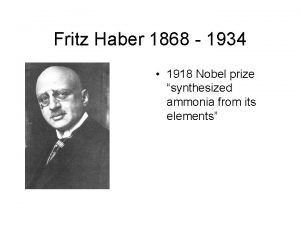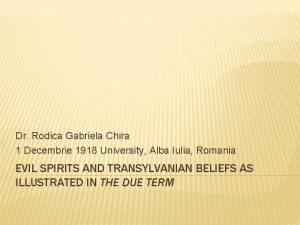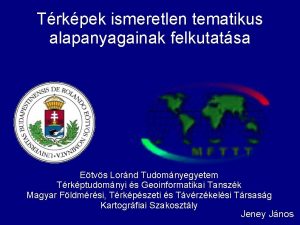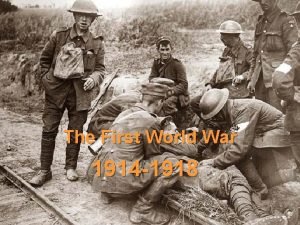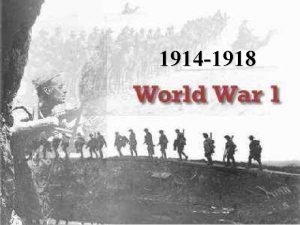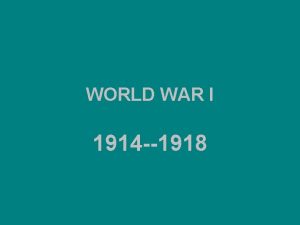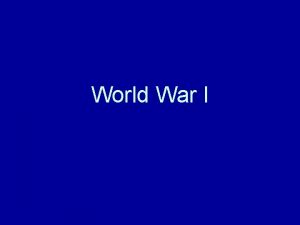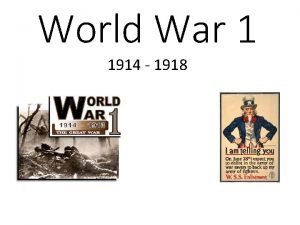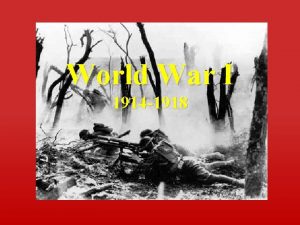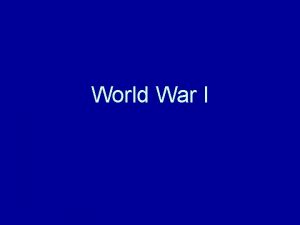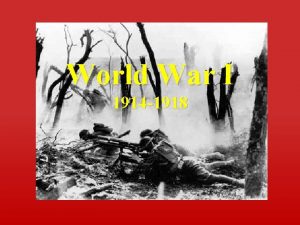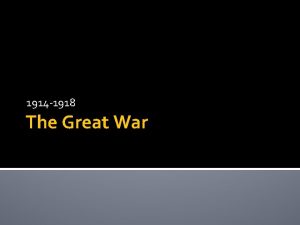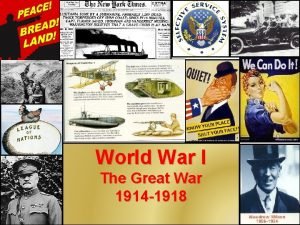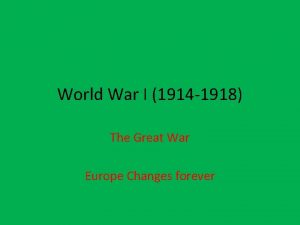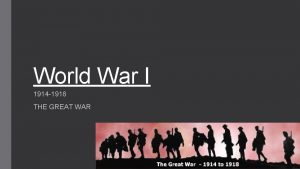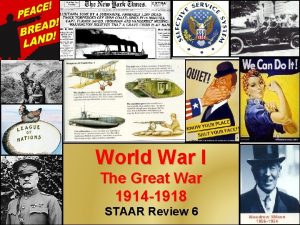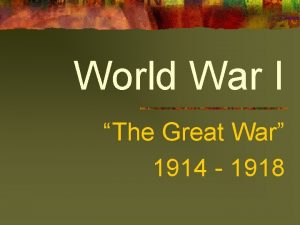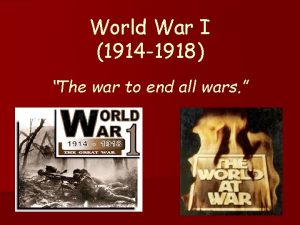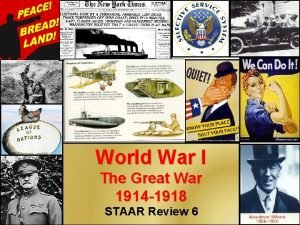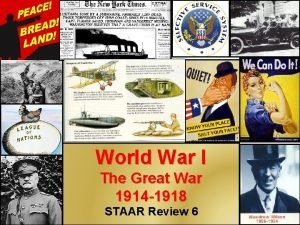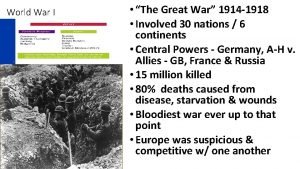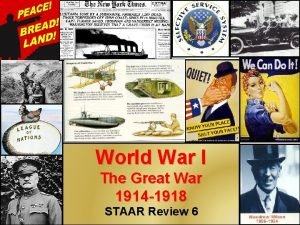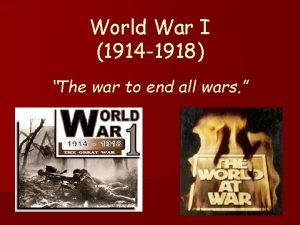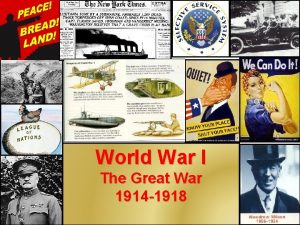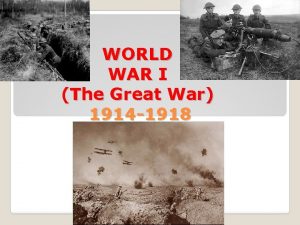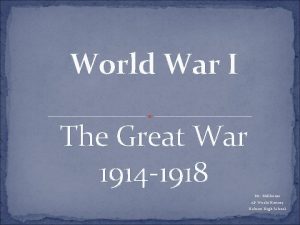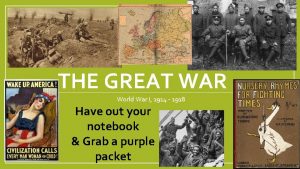HIGHLIGHTS OF WORLD WAR I 1914 1918 Chapter









































































- Slides: 73

HIGHLIGHTS OF WORLD WAR I 1914 -1918

Chapter 14. 1 – The U. S. Enters WW I n n n Woodrow Wilson’s Diplomacy (pages 448– 449) President Wilson was opposed to imperialism and believed democracy was necessary to keep the nation stable and prosperous. He wanted a world free from revolution and war.

Chapter 14. 1 – The U. S. Enters WW I n n In 1911 a revolution in Mexico forced its leader, Porfirio Díaz, to flee the country. The new leader, Francisco Madero, was a poor administrator. General Victoriano Huerta took over in Mexico and presumably had Madero murdered. Wilson refused to recognize the new government and prevented weapons from reaching Huerta.

Chapter 14. 1 – The U. S. Enters WW I n In 1914 Wilson sent marines to seize the Mexican port of Veracruz to overthrow Huerta. n n Anti-American riots broke out in Mexico. International mediation of the dispute placed Venustiano Carranza as Mexico’s new president.

Chapter 14. 1 – The U. S. Enters WW I n n n Mexican forces opposed to Carranza conducted raids into the United States, hoping Wilson would intervene. Pancho Villa led a group of guerrillas, an armed group that carries out surprise attacks, into New Mexico, and a number of Americans were killed.

Chapter 14. 1 – The U. S. Enters WW I n n Wilson sent General John J. Pershing and his troops into Mexico to capture Villa. Pershing was unsuccessful. Wilson’s Mexican policy damaged U. S. foreign relations.

Short Term Cause of World War I: The Spark n n June 28, 1914 Assassinationof the heir to the throne of Austria-Hungary, Franz Ferdinand his wife Sophie. Attack was in Sarajevo, Serbia Assassin was Gavrilo Princip, a member of a Serbian Nationalist Group: The Black Hand, .


GAVRILO PRINCIP n Memberof the Serbian Nationalist Group known as the Black Hand assassin of the Archduke.

RIVAL ALLIANCE SYSTEM n n Serbian nationalists wanted to unite Bosnia and Herzegovina with Serbia. Austria-Hungary blamed the assassination of the Archduke on Serbia. Germany is an ally to Austria-Hungary and issues the “blank check” to A-H. Serbia rejects key points of the ultimatum.

Sequence of Events n n July 28, 1914 – Austria-Hungary mobilizes against Serbia and declares war. Russia begins general mobilization. Why? August 1, 1914 – Germany invades Belgium and declares war on France. August 3, 1914 – Italy declares neutrality.

Sequence of Events n n August 23, 1914 – Japan declares war on Germany. July 3 – Turkey concludes a secret treaty with Germany against Russia and declares war on Russia on October 29. November 3 – Russia declares war on Turkey May 23, 1915 – Italy joins the Allies by declaring war on Austria-Hungary.

Sinking of the Lusitania May 7, 1915

Zimmerman Telegram n n Letter sent by a German Official, Arthur Zimmerman, to Mexico asking Mexico to ally itself with Germany against the United States in exchange for regaining its territories lost earlier to the United States. Suggested an invasion of the United States by Mexico.


UNITED STATES ENTERS WORLD WAR I n April 6, 1917

CENTRAL POWERS WAR STRATEGY n SCHLIEFFEN PLAN

14. 2 – The Homefront Building Up the Military n n As the United States entered the war; it was necessary to recruit more soldiers. Conscription - forced military service A new system, called selective service, resulted in about 2. 8 million Americans being drafted. https: //www. youtube. com/watch? v=W 9 f. GD 8 C U 6 KI

Building Up the Military n n n African American soldiers faced discrimination and prejudice within the army. they served in racially segregated units. Many. African Americans won praise from their commanders and received war medals.

Building Up the Military n n World War I was the first war in which women officially served. The navy enlisted some 11, 000 women, whose jobs included clerics, pharmacists, and photographers. The hired them as temporary employees to fill clerical positions. Army nurses were the only women in the military to go overseas during the war.

Organizing Industry n n n The American economy had to mobilize for war. President Wilson and Congress wanted to establish a cooperative relationship between big business and government. The goal was to ensure efficient use of resources during the mobilization of the American economy for war.

Organizing Industry n n n In 1917 the War Industries Board (WIB) was created to coordinate the production of administered by Bernard Baruch. The Food Administration, under the direction of Herbert Hoover, was responsible for increasing food production while reducing consumption.


Organizing Industry n n Hoover asked people to plant victory gardens to raise their own vegetables in order to leave more food for the troops. The Fuel Administration encouraged people to conserve coal and oil. Daylight savings time was introduced to conserve energy.

Mobilizing the Workforce n n n To prevent strikes, the government established the National War Labor Board (NWLB) in 1918. In exchange for wage increases, an 8 -hour workday, and the right to organize unions and bargain collectively, the labor leaders agreed not to disrupt war production with a strike.

Organizing Industry n n Between 300, 000 and 500, 000 African Americans left the South to settle in the North for jobs. This “Great Migration” changed the racial makeup of many Northern cities.


Organizing Industry n n Schenck v. the United States (1919), the Supreme Court limited an individual’s freedom of speech if the words spoken constituted a “clear and present danger. ”

Ensuring Public Support n n The Committee on Public Information (CPI) attempted to “sell” the idea of war to the American people with patriotic messages. Espionage - spying to acquire secret government information Espionage Act of 1917 set consequences for people who aided the enemy. The Sedition Act of 1918 made it illegal to criticize the president or the government.

Ensuring Public Support To raise money to pay for the war, the government began selling Liberty Bonds and Victory Bonds. n By buying bonds, Americans were loaning the government money that would be repaid with interest in a specified number of years. n


ALLIED POWERS WAR STRATEGY

1914 n FIRST BATTLE OF THE MARNE n n Germans had advanced to within 37 miles of Paris, France. Schlieffen plan failed because of Belgium. Germans withdrew to a strong defensive position. War on the Western Front settled into a STALEMATE due to TRENCH WARFARE Neither side moved more than 10 miles in the next three years

TRENCH WARFARE


NO MAN’S LAND

1914 n AUGUST – BATTLE OF TANNENBURG n n Eastern Front between Russia and Germany. Disaster for the Russians General von Hindenburg and General Ludenforff made famous. By 1915 – Russia had lost 1 million dead and 900, 000 prisoners. They were not trained or equipped properly.


1915 n April – Second Battle of Ypres n n Germany introduced poison gas to warfare. Total number of casualties from gas on both sides would reach 1 million with 79, 000 killed.

1915 n MAY – SINKING OF THE LUSITANIA

LUSITANIA n n n Germany’s submarine blockade of England resulted in the sinking of the Lusitania in May. This event led to great tension between the United States and Germany. 1, 198 dead including 139 Americans

LUSITANIA

GALLIPOLI CAMPAIGN n n APRIL, 1915 TO JANUARY, 1916 Plan of WINSTON CHURCHILL to knock Turkey out of the war. British disaster with 50, 000 troops killed Turkish military leader MUSTAFA KEMAL would later rule Turkey as “ATATURK”.

GALLIPOLI CAMPAIGN

1916 n MAY – BATTLE OF JUTLAND n n n Only major naval battle of WWI. German navy was outnumbered but inflicted heavy losses on the British fleet basically out for the rest of the war.

BATTLE OF JUTLAND

1916 n BATTLE OF VERDUN (FEB-OCT) n n n Fought in France. Longest and bloodiest battle of the war. This battle killed almost 1 million men. 542, 000 French n 434 German n

1916 n BATTLE OF THE SOMME (JULY-NOV) n n n The British attacked with an advantage of 6: 1. Highest casualty rate in one day of both world wars. 60, 000 men killed in the first day of battle. The British introduced the tank in battle. Casualties: n n 500, 000 German 400, 000 British 200, 000 French Net Gain: 7 miles


1917 Year of Disasters for the Allies n n Germany began Unrestricted Submarine Warfare. German blockade of England. (Starve them out) Convoy System – protection of ships to deliver supplies to England. Hindenburg Line established – a series of trenches across northern France.


HINDENBURG LINE

HINDENBURG LINE

WORLD WAR I BRITISH TANK

ZIMMERMAN TELEGRAM n Telegram to the German Minister in Mexico saying if the United States went to war, Germany would form an alliance with Mexico to help them get back “lost territories” from the U. S. in the 1840’s.


1917 n BOLSHEVIK REVOLUTION (NOV. ) n n n End of Tsarist Russia. Led to Russian armistice with Germany which takes Russia out of the war. Nov. 15 - Tsar Nicholas II Abdicates. Vladimir Lenin established Communist government in Russia. TREATY OF BREST-LITOVSK – Between Germany and Russia.

Nicholas II and Family


ALEXI: TSARAVICH AND HEMOPHELIA

RASPUTIN

RASPUTIN’S PROPHETIC LETTER TO ALEXANDRA

RASPUTIN ASSASSINATED


BOLSHEVIK REVOLUTION

VLADIMIR LENIN

END OF TSARIST RUSSIA

IPATIEV HOUSE n http: //www. romanov-memorial. com/

1918 n n n President Wilson announces his Fourteen Points. One Million fresh American troops land in France. Second Battle of the Marne (July-August) was the turning point of the war. Germans were forced to retreat

1918 n MEUSE-ARGONNE OFFENSIVE n n n Alvin C. York made famous American army of 1, 200, 000 under the command of General John J. Pershing Pursued the retreating German s until the German armistice

MEUSE-ARGONNE OFFENSIVE

1918 n Mutiny of the German fleet and a revolution in Munich led to the abdication of Kaiser Wilhelm II on Nov. 10. The Kaiser fled to Holland.

ARMISTICE n n Agreement to end fighting. 11 th day 11 th month 11 th hour
 1914 1918
1914 1918 Who reorganized the war industries board in 1918
Who reorganized the war industries board in 1918 1914 world series
1914 world series World population 1914
World population 1914 Chapter 30 the war to end war
Chapter 30 the war to end war Chapter 30 the war to end war
Chapter 30 the war to end war Feature highlights
Feature highlights Proposal highlights
Proposal highlights Highlights memorandum
Highlights memorandum Investment highlights
Investment highlights Highlights from the book of isaiah
Highlights from the book of isaiah Highlights from the book of isaiah
Highlights from the book of isaiah Illustration of activities performed
Illustration of activities performed The passage highlights……
The passage highlights…… Principle of arts
Principle of arts Chapter 16 world war looms vocabulary
Chapter 16 world war looms vocabulary Chapter 16 building vocabulary world war looms
Chapter 16 building vocabulary world war looms World war 1 and the russian revolution chapter 27
World war 1 and the russian revolution chapter 27 Chapter 27 lesson 4 world war 1 ends
Chapter 27 lesson 4 world war 1 ends Chapter 24 world war looms section 1 answers
Chapter 24 world war looms section 1 answers Chapter 37 new conflagrations world war ii
Chapter 37 new conflagrations world war ii Lesson 1 instability after world war i
Lesson 1 instability after world war i Dictators threaten world peace chapter 24 section 1 answers
Dictators threaten world peace chapter 24 section 1 answers Chapter 23 living in a world at war
Chapter 23 living in a world at war Chapter 16 building vocabulary world war looms
Chapter 16 building vocabulary world war looms Chapter 16 world war looms vocabulary
Chapter 16 world war looms vocabulary Kzbho6asboc -site:youtube.com
Kzbho6asboc -site:youtube.com Chapter 16 world war looms answer key
Chapter 16 world war looms answer key Chapter 24 world war looms
Chapter 24 world war looms Chapter 24 world war looms
Chapter 24 world war looms Chapter 11 guided reading world war 1 begins
Chapter 11 guided reading world war 1 begins Chapter 11 section 1 the civil war begins
Chapter 11 section 1 the civil war begins World war 1 begins chapter 11 section 1
World war 1 begins chapter 11 section 1 A global conflict chapter 13 section 3
A global conflict chapter 13 section 3 Chapter 9 america in world war 1
Chapter 9 america in world war 1 Chapter 27 lesson 1
Chapter 27 lesson 1 Chapter 24 world war looms
Chapter 24 world war looms Chapter 19 section 1 world war 1 begins
Chapter 19 section 1 world war 1 begins Map of europe 1914
Map of europe 1914 Angelika dudek
Angelika dudek Poesia ungaretti soldati
Poesia ungaretti soldati Varför kallas perioden 1918-1939 för mellankrigstiden
Varför kallas perioden 1918-1939 för mellankrigstiden Ft17
Ft17 1918-1862
1918-1862 Jim crow (character)
Jim crow (character) 1918 18 novembris
1918 18 novembris What is the red scare
What is the red scare Georgia history timeline 1877-1919
Georgia history timeline 1877-1919 Proiecte 1 decembrie
Proiecte 1 decembrie 1918-1862
1918-1862 1918-1862
1918-1862 1918-1862
1918-1862 Louisiana 1918 poll tax receipt
Louisiana 1918 poll tax receipt 1918 18 novembris
1918 18 novembris 11 listopada 1918 piosenka tekst
11 listopada 1918 piosenka tekst 1918-1862
1918-1862 Jaan poska
Jaan poska 1918 18 novembris
1918 18 novembris Gustv klimt
Gustv klimt Palestina 1918
Palestina 1918 Revisal hg 500 din 2011 download
Revisal hg 500 din 2011 download Lịch sử hà nội từ năm 1802 đến năm 1918
Lịch sử hà nội từ năm 1802 đến năm 1918 1918-1862
1918-1862 1918-1862
1918-1862 1918-1862
1918-1862 1918-1862
1918-1862 When did the kaiser abdicate
When did the kaiser abdicate Hammer v dagenhart 1918
Hammer v dagenhart 1918 Personaggio storico nato 1862
Personaggio storico nato 1862 1918 nobel prize winners
1918 nobel prize winners 1 decembrie 1918 university
1 decembrie 1918 university What is shaded
What is shaded Európa térképe 1914-ben
Európa térképe 1914-ben Colonial empires 1914
Colonial empires 1914
